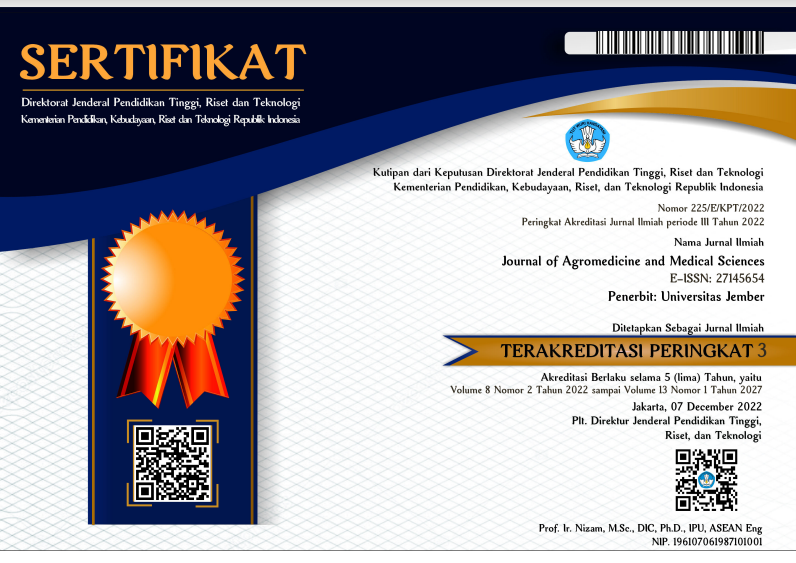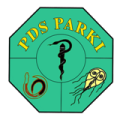The Use of Saturated MgSO4 Compared to Saturated Sucrose in the Flotation Method to Identify Eggs and Larvae of Soil-Transmitted Helminths from Plantation Soil
DOI:
https://doi.org/10.19184/ams.v7i2.17093Abstract
Worms infection is still common in Indonesia with a prevalence that varies around 40% -60% at all ages. This disease can be caused by infection of Soil-Transmitted Helminths (STH) that require soil media to infect humans. The many plantation lands in Jember are a suitable environment for the development of STH and STH identification in soil can be done by flotation method using MgSO4 solution or sucrose. The comparison of the effectiveness of the MgSO4 solution with the sucrose solution has not been widely studied. Therefore, the aim of this study was to compare the efficacy of using saturated MgSO4 solution with saturated sucrose to identify eggs and larvae of STH in Sumber Wadung plantation soil, Hargomulyo Village, Silo District, Jember Regency using the flotation method. Soil samples were taken as many as 35 samples in the garden area, 35 samples around the river, and 35 samples in residential areas,. The results of identification of STH eggs and larvae obtained Ascarid eggs (1.9%) and Hookworm larvae (0.01%). The number of positive soil samples containing STH eggs and larvae using different solutions is the same as three samples (0.02%).The Wilcoxon test results showed that there was no difference in the results of using the MgSO4 solution with the sucrose solution in the flotation method (p> 0.05) so that the MgSO4 solution and sucrose solution could be used to detect eggs and larvae of STH worms and had the same effectiveness.
Keyword: Soil-transmitted helminths, saturated MgSO4, saturated sucrose, flotation
Downloads
References
Annisa, S., Dalilah, C. Anwar, dan Novrikasari. 2018. The relationship between soil transmitted helminthes (STH) infection and nutritional status in students of state elemtary school number (SDN) 200 Palembang Indonesia. Bioscientia Medicina. 2(2): 42-53. https://doi.org/10.32539/bsm.v2i2.39
Ayres, R. M. dan D. D. Mara. 1996. Analysis of Wastewater for Use in Agriculture: A Laboratory Manual of Parasitological and Bacteriological Techniques. Geneva: World Health Organization. 21-25.
Baidowi, I. I, ArmiyantiY, Febianti Z., Nurdian Y, Hermansyah B. 2019. The Correlation Between The Use of Personal Protective Equipment (PPE) and Soil-Transmitted Helminths Infection in the Workers of Kaliputih Plantation Jember Regency. Journal of Agromedicine and Medical Sciences. 5(2):1-8. https://doi.org/10.19184/ams.v5i2.9625
Barus, dan L. R. Hannie. 2018. Prevalensi infeksi kecacingan yang ditransmisikan melalui tanah (Soil Transmitted Helminths) pada anak-anak pengungsi erupsi Gunung Sinabung Kabanjahe Kabupaten Karo Sumatera Utara. Skripsi. Medan: Fakultas Matematika dan Ilmu Pengetahuan Alam Universitas Sumatera Utara.
BPS Kab Jember. 2017. Kabupaten Jember dalam Angka 2017. https://jemberkab.bps.go.id/publication/2017/08/20 (Diakses 26 April 2018).
Collender, P. A., A. E. Kirby, D. G. Addiss, M. C. Freeman, dan J. V. Remais. 2015. Methods for quantification of soil-transmitted helminths in environmental media: current techniques and recent advances. Trends in Parasitology. 31(12):625–639. doi: 10.1016/j.pt.2015.08.007
Cringoli, G. 2006. FLOTAC, a novel apparatus for a multivalent faecal egg count technique. Parassitologia. 48:381-384.
Departemen Kesehatan RI. 2015. Sistem Kesehatan Nasional. http:// www.depkes.go.id [Diakses pada 11 Februari 2020].
Dryden, M.W., P. A. Payne, R. K. Ridley, dan V, E. Smith. 2006. Gastrointestinal parasites: the practice guide to accurate diagnosis and treatment. Compend Contin Educ Vet. 28.
Horiuchi, S., V. G. Vachel, dan U. Shoji. 2013. Soil contamination by parasite eggs in rural village in the Philippines. Tropical Biomedicine. 30(3): 495-503.
Jex, A. R., Y. A. L. Lim, J. M. Bethony, P. J. Hotez, N. D. Young, dan R. B. Gasser. 2011. Soil-transmitted helminths of humans in southeast asia--towards integrated control. Advances in Parasitology. 74:231–265. doi: 10.1016/B978-0-12-385897-9.00004-5.
Ketut N. 1996. Pengaruh Magnesium Sulfat Proanalisis dan Garam Inggris serta Periode Opsional terhadap Efektivitas Pemeriksaan Tinja Flotasi. 109:35-38.
Lim, M. D., S. J. Brooker, V. Y. Belizario, F. Gay-Andrieu, J. Gilleard, B. Levecke, L. van Lieshout, G. F. Medley, Z. Mekonnen, G. Mirams, S. M. Njenga, M. R. Odiere, J. W. Rudge, L. Stuyver, J. Vercruysse, J. Vlaminck, J. L. Walson, dan the Annecy STH diagnostic experts group. 2018. Diagnostic tools for soil-transmitted helminths control and elimination programs: a pathway for diagnostic product development. PLOS Neglected Tropical Diseases. 12(3): 486-491. doi: 10.1371/journal.pntd.0006213
Limpomo, A. B. 2014. Perbedaan Metode Flotasi Menggunakan Larutan ZnSO4 Dengan Metode Kato Katz Untuk Pemeriksaan Kuantitatif Tinja. Skripsi. Semarang: Program Pendidikan Sarjana Kedokteran Fakultas Kedokteran Universitas Diponegoro.
Mahartika, R. P. Armiyanti Y., Abrori C. 2019. Difference between Location of Soil with Risk of Contamination of Soil-transmitted Helmints Eggs and Larvae (Observational Study of Coffee Plantation Area in Silo District, Jember Regency). Journal of Agromedicine and medical Sciences. 5(3):136-140. DOI: https://doi.org/10.19184/ams.v5i3.9468
Margono, S. S. 2000. Parasitologi Kedokteran. Edisi ketiga. Jakarta: Balai Penerbit FKUI.
Muttaqien, M. A. 2019. Identifikasi Kontaminasi Tanah oleh Telur dan Larva Soil-Transmitted Helminthes di Daerah Perkebunan Gunung Pasang Kabupaten Jember. Skripsi. Jember: Fakultas Kedokteran Universitas Jember.
Muzaky, A. H., A.Hermansyah B., Suswati E., Armiyanti Y., Nurdian Y. 2019. Hubungan Perilaku Hidup Bersih dan Sehat dengan Kejadian Infestasi Soil-Transmitted Helminths pada Pekerja Perkebunan Kopi Sumber Wadung Kabupaten Jember. Jurnal Kedokteran dan Kesehatan. 6(1): 7-15.
Nkouayep, V. R., Tchakounte, B. N., dan Pone, J. w. 2017. Profile of geohelminth eggs, cysts, and oocysts of protozoans contaminating the soils of ten primary schools in Dschang, West Cameroon. Journal of Parasitology Research 2017. 1-6. doi: 10.1155/2017/1534675
Nundrisari, D. 2019. Hubungan Antara Sanitasi Lingkungan dan Higiene Perorangan dengan Kejadian Infeksi Soil-Transmitted Helminthes pada Pekerja Perkebunan Garahan Kidul. Skripsi. Jember: Fakultas Kedokteran Universitas Jember.
Nurdian, Y. 2004. Soil Contamination by Intestinal Parasite Eggs in Two Urban Villages of Jember. Jurnal Ilmu Dasar. 5(1): 51-55.
Nurdian, Y dan H. Kurniawati. 2005. Identifikasi kontaminasi telur dan larva Cacing parasit pada tanah daerah Perkebunan Mumbulsari, Kabupaten Jember. Biomedis. (3)1: 15-29.
Nurfalaq, D. K. G., I. Saleh, dan Rochmawati. 2015. Hubungan Karakteristik Individu, Sanitasi Lingkungan Rumah, Personal Hygiene, Penggunaan APD dan Lama Bekerja dengan Kejadian Infestasi STH (Studi pada Petani di Desa Nusapati Kecamatan Sungai Pinyuh Kabupaten Mempawah). Jurnal Universitas Muhammadiyah Pontianak.
Pasaribu, A. P., A. Alam, K. Sembiring, S. Pasaribu, dan D. Setiabudi. 2019. Prevalence and risk factors of soil-transmitted helminthiasis among school children living in an agricultural area of north sumatera, indonesia. BMC Public Health. 19(1):1066-1068. https://doi.org/10.1186/s12889-019-7397-6
Rebecca, T. 2013. Standard Operating Procedure: Faecal Floats-Using Sodium nitrate (modified ‘Faecalizer’method) and Zinc Sulfate flotation [pamphlet]. The University of Queensland Australia.
Savitrie, D. W. R. 2014. Comparative Effectiveness And Optional Period of The Flotation Method Using NaCl, ZnSO4, And MgSO4 For The Diagnostic of Soil-Transmitted Helminths. Skripsi. Semarang: Program Pendidikan Sarjana Kedokteran Fakultas Kedokteran Universitas Diponegoro.
Silva, A. S. da, R. A. Zanette, M. A. Otto, C. D. M. Soares, S. H. Alves, S. G. Monteiro, dan J. M. Santurio. 2009. Duddingtonia flagrans: centrifugal flotation technique with magnesium sulphate for the quantification and qualification of chlamydospores in sheep faeces. Experimental Parasitology. 121(2):187–188. doi: 10.1016/j.exppara.2008.10.005.
Steinbaum, L., L. H. Kwong, A. Ercumen, M. S. Negash, A. J. Lovely, S. M. Njenga, A. B. Boehm, A. J. Pickering, dan K. L. Nelson. 2017. Detecting and enumerating soil-transmitted helminth eggs in soil: new method development and results from field testing in kenya and bangladesh. PLOS Neglected Tropical Diseases. 11(4): 1-13. https://doi.org/10.1371/journal.pntd.0005522
Sutanto, I., I. S. Ismid., P. K. Sjariffudin dan S. Sungkar. 2008. Buku Ajar Parasitologi Kedokteran. Edisi Keempat. Jakarta: Badan Penerbit FK UI.
Syavira, N. A. 2018. Identifikasi Pencemaran Tanah Oleh Telur dan Larva Soil-Transmitted Helminths Di Desa Klungkung, Kecamatan Sukorambi, Kabupaten Jember. Skripsi. Jember: Fakultas Kedokteran Universitas Jember.
Uga, S., N. T. V. Hoa, S. Noda, K. Moji, L. Cong, Y. Aoki, S. K. Rai, dan Y. Fujimaki. 2009. Parasite egg contamination of vegetables from a suburban market in hanoi, vietnam. Nepal Medical College Journal: NMCJ. 11(2):75–78. PMID: 19968142.
USEPA. 1999. Test Method for Detecting, Enumerating, and Determining the Viability of Ascaris Ova in Sludge. 616–622.
World Health Organization. 2018. Soil-transmitted Helminth Infections. http://www.who.int/newsroom/factsheets/detail/soil-transmittedhelminth infection [Diakses pada 11 Februari 2020].
Yuliarto, R. P. 2019. Perbandingan Penggunaan ZnSO4 Jenuh dan MgSO4 Jenuh pada Metode Flotasi dalam Mendeteksi Kontaminasi Tanah oleh Soil-Transmitted Helminthes. Skripsi. Jember: Fakultas Kedokteran Universitas Jember.























